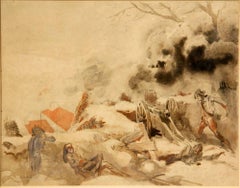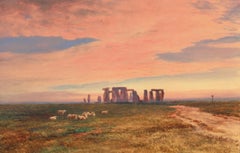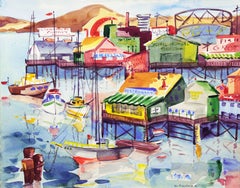Illustration Board Landscape Drawings and Watercolors
to
2
Overall Width
to
Overall Height
to
2
2
2
2
1
1
1
1
1
3
3
2
2
2
8
4
2
1
1
2
2
Medium: Illustration Board
Artist: Everett Shinn
Attributed to; Design for the Battle of Lexington Scene in 1924 Film "Jani
Located in Fort Washington, PA
Medium: Watercolor and Graphite on Illustration Board
Signature: Unsigned, Marked "Cosmo #51" Lower Left
Contact for exact dimensions.
Christies stamp verso. In silver molded frame, french-lined mat, glazed. OS: 18 1/2" x 22", SS: 11" x 15". Shinn took over from Joseph Urban as the Art Director on the William Randolph Hearst...
Category
20th Century Illustration Board Landscape Drawings and Watercolors
Materials
Watercolor, Illustration Board, Graphite
Attributed to; Design for the Battle of Brooklyn Heights Scene in 1924 Film
Located in Fort Washington, PA
Medium: Watercolor and Graphite on Illustration Board
Signature: Unsigned, Christies Stamp Verso.
In silver molded frame, french-lined mat, glazed. OS: 18 1/2" x 22", SS: 11" x 15". Shinn took over from Joseph Urban as the Art Director on the William Randolph Hearst's Cosmopolitan Pictures film, shot in New York City and Tarrytown, NY. Directed by E. Mason Hopper, starring Marion Davies...
Category
20th Century Illustration Board Landscape Drawings and Watercolors
Materials
Watercolor, Illustration Board, Graphite
Related Items
'Stonehenge at Sunset', Royal Academy, RSBA, Benezit, Wiltshire, Druid, Celtic
Located in Santa Cruz, CA
Signed lower left, 'R. Gallon' for Robert Gallon (English, 1845-1925) and painted circa 1880.
This well-listed landscape and seascape painter maintained a studio in St John's Wood, ...
Category
Late 19th Century Romantic Illustration Board Landscape Drawings and Watercolors
Materials
Watercolor, Illustration Board
'Fisherman's Wharf, Monterey', Modernist California Artist, Crocker Art Museum
Located in Santa Cruz, CA
Signed lower right, "M. Backman" for Muriel Backman (American, 1902-1996), titled verso and dated 1955.
A vibrant Modernist work by this notable California woman artist who exhibit...
Category
1950s Post-Impressionist Illustration Board Landscape Drawings and Watercolors
Materials
Watercolor, Illustration Board, Graphite
'South-Western Landscape', Art Institute of Chicago, Whitney Museum, WPA, Odessa
Located in Santa Cruz, CA
Signed 'Todros Geller' (Russian-American, 1889-1949) and dated 1937
An elegant and painterly, southwestern landscape painted when the artist was 48 years old.
Born in Vinnytsia, now in the Ukraine, Todros Geller first studied in Odessa before moving to Canada. He continued his studies in Montreal (1906) and, subsequently, at the Art Institute of Chicago with George Bellows and John Norton. Geller exhibited widely and with success including, from 1925, at the Chicago Art Institute as well as at the Riverside Museum (New York, 1939), the New York World's Fair (1939) and at the Whitney Museum of American Art (1941) in addition to other national institutions.
Geller was the recipient of numerous prizes, medals and juried awards and his work may be found in private and public collections including the permanent collection of the Art Institute of Chicago. He was a member of professional associations including the Artist's Union, the Artist's Congress and the Chicago Society of Artists, which he also served as president. During the the 1930's, Geller was an active participant in the Federal Art Project (WPA) in Illinois and his large-scale murals and stained glass windows may be found in Chicago and Detroit as well as Tel-Aviv. We are pleased to offer this elegant, South-Western landscape painted when the artist was 45.
Reference:
Todros Geller Archives, Spertus Museum of Judaica, Chicago; Sparks, Esther. "A Biographical Dictionary of Painters and Sculptors in Illinois 1808-1945." Diss., Northwestern University, 1971, p. 390; Yochim, Louise Dunn. Role and Impact: The Chicago Society of Artists. Chicago: 1979, pp. 28, 44, 238; Mavigliano, George J. and Richard A. Lawson. The Federal Art Project in Illinois 1935-1943. Carbondale: Southern Illinois University Press, 1990, p. 120; Dijkstra, Bram. American Expressionism: Art and Social Change 1920-1950. New York: Harry N. Abrams, Inc., 2003, p. 155. Chicago Modern...
Category
1930s Modern Illustration Board Landscape Drawings and Watercolors
Materials
Watercolor, Gouache, Illustration Board
H 14.5 in W 17.5 in D 0.13 in
Loading the Cargo Ship - Brittany France - Watercolor 19th Century
Located in Soquel, CA
French Coastal Scene in Brittany with a merchant ship onloading fish and people by an unknown artist. A sailing vessel is anchored at a beach. A r...
Category
Late 19th Century Impressionist Illustration Board Landscape Drawings and Watercolors
Materials
Watercolor, Postcard, Illustration Board
H 14.75 in W 18 in D 0.75 in
'The Thief from François Villon's Christmas', San Francisco Bay Area Illustrator
Located in Santa Cruz, CA
Signed lower right, 'James March Phillips' (American, 1913-1981) and painted circa 1965.
Displayed in an original card mat decorated by the artist. Signed lower right, in pencil, 'J. M. Phillips' and titled, lower left, ''The Thief' - from Francois Villon's Christmas'. Mat dimensions: 16 x 13 inches.
Born in California, James March Phillips first studied in San Francisco at the Jean Turner Art Academy and, later, under Alfred Owles...
Category
1960s Realist Illustration Board Landscape Drawings and Watercolors
Materials
Gouache, Illustration Board
"San Anton Palace Malta" Early 20th Cent. Garden and Fountain Watercolor Russian
Located in Soquel, CA
A significant early 20th century landscape watercolor of the paradisical gardens at San Anton Palace in Attard, Malta by Nicholas Krasnoff, 1920 (Russian, 1864-1939). This beautiful piece is a wonderful example of the renowned Russian architect's prized watercolors, created while he was exiled to Malta in the early 1920's. Depicting a lush garden full of blooming, colorful flowers and a stately fountain at the San Anton Palace in Malta, one can see the deft hand and attention to detail rendered by the proficient artist and architect's hand.
Signed "N. Krasnoff" lower right. Titled and dated "Malta, St. Antonio 1920".
Unframed.
Measures 10.25"H x 14.25"W.
Right corner has a crease from being bent.
Nikolay Petrovich Krasnov, also known as Nicholas Krasnoff or Peter Nicholas Krasnoff, was a Russian Serbian architect and painter. He served as Chief Architect of Yalta, Crimea (1887-1899). From 1922 he lived and worked in the Kingdom of Yugoslavia, and was a key figure in the architectural development of Belgrade. Attending the Moscow School of Painting, Sculpture and Architecture in 1876, aged 12. As a young artist he received patronage from Sergey Tretyakov, brother of the founder of Moscow's Tretyakov Gallery, and entrepreneur Petar Gubonyin.
In 1887 Krasnov became Chief Architect in Yalta. At the age of 23, Krasnov had large responsibility for the rapid growth of the city. He expanded the promenade, which by 1913 became the city's main street, before creating a new city plan in 1889 (including a new sewer system, planning regulations, new streets, prevention of unregulated construction, a school and children's hospital, and the construction of the Pushkin Boulevard). Two concrete bridges were built over the river, and the embankment strengthened. Krasnov also ran a private practice in Yalta until 1911. Among his most famous work is the Livadia Palace, later the location of the 1945 Yalta Conference. Designed over 60 buildings in Crimea, blending a modernist style with local traditions. Also of note: Dulber Palace, Koreiz (1895-97), Alexander Nevsky Cathedral, Yalta (1902), Yusupov Palace, Koreiz (1909), Kokkoz Jami Mosque, Sokolyne (1910).
In 1913, he presented a collection of illustrations he had produced of his works to the Saint Petersburg Academy of Arts, where he held the title of academician. An opponent of the Russian Revolution, he left Yalta with his family in 1919 for Malta, alongside the Dowager Empress Marie Feodorovna, sister of Queen Alexandra, and over 600 members of the Russian aristocracy. Nikolay was in a group housed in the empty Villa St Ignatius, which had been a Jesuit college and then a hospital during World War I. To earn money, Nikolay painted many scenes of Malta, signing his paintings as N. Krasnoff. He is known as Nicholas Krasnoff in Malta. In May 2016 MaltaPost issued a commemorative set of stamps in his honor.
In 1922 Krasnov moved to Belgrade, then part of the Kingdom of Yugoslavia, where he became head of the Department of Monumental Architectural Developments and Monuments. His building designs in Serbia number around 60, and were created under the name Nikola Krasnov, as a mark of respect to his adopted homeland.
His key works in Belgrade include: Ministry of Forestry building (now Ministry of Foreign Affairs) (1923) which bears a memorial plaque...
Category
1920s Impressionist Illustration Board Landscape Drawings and Watercolors
Materials
Paper, Watercolor, Illustration Board
H 10.25 in W 14.25 in D 0.13 in
'Old Reliable', Early American Modernist, Jalopy, Model T Ford Flatbed Truck
Located in Santa Cruz, CA
An American School watercolor showing an old Ford Model T flatbed truck backed up to a barn in a rural landscape.
A well-composed work paint...
Category
1920s Modern Illustration Board Landscape Drawings and Watercolors
Materials
Watercolor, Gouache, Illustration Board
H 13.75 in W 20 in D 0.07 in
Harvest Time The Hills of Mt Tamalpais near Lake Bon Tempe 1890s
Located in Soquel, CA
Harvest Time The Hills of Mt Tamalpais near Lake Bon Tempe 1890s
The Hills around San Rafael in the 19th century were a time of work and play as seen in this watercolor near Lake Bon...
Category
Late 19th Century American Impressionist Illustration Board Landscape Drawings and Watercolors
Materials
Watercolor, Illustration Board, Laid Paper
H 21.75 in W 11.5 in D 0.07 in
Whimsical Illustration "Snow" Cartoon, 1938 Mt Tremblant Ski Lodge William Steig
Located in Surfside, FL
Lighthearted Illustration of Outdoor Pursuits This one being cross country Snow Shoes signed "W. Steig"
Provenance: from Mrs. Joseph B. Ryan, Commissioned by ...
Category
1930s American Modern Illustration Board Landscape Drawings and Watercolors
Materials
India Ink, Watercolor, Illustration Board
Sydney, Australia, from Darling Point
By Brett Hilder
Located in Santa Cruz, CA
A delicate watercolor landscape showing a panoramic view of Australia's capital city looking towards Sydney Harbor Bridge from this desirable eastern sub...
Category
1960s Illustration Board Landscape Drawings and Watercolors
Materials
Watercolor, Illustration Board
Whimsical Illustration Skiing Cartoon, 1938 Mt Tremblant Ski Lodge William Steig
Located in Surfside, FL
Lighthearted Illustration of Outdoor Pursuits This one being a Skiing scene, a boy and a girl on skis. signed W. Steig
Provenance: from Mrs. Joseph B. Ryan, Commissioned by Joe Ryan for the bar at his ski resort, Mount Tremblant Lodge, in 1938.
Mont Tremblant, P.Q., Canada
Watercolor and ink on illustration board, sights sizes 8 1/2 x 16 1/2 in., framed.
In 1938 Joe Ryan, described as a millionaire from Philadelphia, bushwhacked his way to the summit of Mont Tremblant and was inspired to create a world class ski resort at the site. In 1939 he opened the Mont Tremblant Lodge, which remains part of the Pedestrian Village today. This original illustration is on Whatman Illustration board. the board measures 14 X 22 inches. label from McClees Galleries, Philadelphia, on the frame backing paper.
William Steig, 1907 – 2003 was an American cartoonist, sculptor, and, in his later life, an illustrator and writer of children's books. Best known for the picture books Sylvester and the Magic Pebble, Abel's Island, and Doctor De Soto, he was also the creator of Shrek!, which inspired the film series of the same name. He was the U.S. nominee for both of the biennial, international Hans Christian Andersen Awards, as a children's book illustrator in 1982 and a writer in 1988.
Steig was born in Brooklyn, New York in 1907, and grew up in the Bronx. His parents were Polish-Jewish immigrants from Austria, both socialists. His father, Joseph Steig, was a house painter, and his mother, Laura Ebel Steig, was a seamstress who encouraged his artistic leanings. As a child, he dabbled in painting and was an avid reader of literature. Among other works, he was said to have been especially fascinated by Pinocchio.He graduated from Townsend Harris High School at 15 but never completed college, though he attended three, spending two years at City College of New York, three years at the National Academy of Design and a mere five days at the Yale School of Fine Arts before dropping out of each.
Hailed as the "King of Cartoons" Steig began drawing illustrations and cartoons for The New Yorker in 1930, producing more than 2,600 drawings and 117 covers for the magazine. Steig, later, when he was 61, began writing children's books. In 1968, he wrote his first children's book. He excelled here as well, and his third book, Sylvester and the Magic Pebble (1969), won the Caldecott Medal. He went on to write more than 30 children's books, including the Doctor DeSoto series, and he continued to write into his nineties. Among his other well-known works, the picture book Shrek! (1990) formed the basis for the DreamWorks Animation film Shrek (2001). After the release of Shrek 2 in 2004, Steig became the first sole-creator of an animated movie franchise that went on to generate over $1 billion from theatrical and ancillary markets after only one sequel. Along with Maurice Sendak, Saul Steinberg, Ludwig Bemelmans and Laurent de Brunhofff his is one of those rare cartoonist whose works form part of our collective cultural heritage.
In 1984, Steig's film adaptation of Doctor DeSoto directed by Michael Sporn was nominated for the Academy Award for Best Animated Short Film. As one of the most admired cartoonists of all time, Steig spent seven decades drawing for the New Yorker magazine. He touched generations of readers with his tongue–in–cheek pen–and–ink drawings, which often expressed states of mind like shame, embarrassment or anger. Later in life, Steig turned to children's books, working as both a writer and illustrator.
Steig's children's books were also wildly popular because of the crazy, complicated language he used—words like lunatic, palsied, sequestration, and cleave. Kids love the sound of those words even if they do not quite understand the meaning. Steig's descriptions were also clever. He once described a beached whale as "breaded with sand."
Throughout the course of his career, Steig compiled his cartoons and drawings into books. Some of them were published first in the New Yorker. Others were deemed too dark to be printed there. Most of these collections centered on the cold, dark psychoanalytical truth about relationships. They featured husbands and wives fighting and parents snapping at their kids. His first adult book, Man About Town, was published in 1932, followed by About People, published in 1939, which focused on social outsiders. Sick of Each Other, published in 2000, included a drawing depicting a wife holding her husband at gunpoint, saying, "Say you adore me."
According to the Los Angeles Times, fellow New Yorker artist Edward Sorel...
Category
1930s Naturalistic Illustration Board Landscape Drawings and Watercolors
Materials
Archival Ink, Watercolor, Illustration Board
'Sunset Landscape with Cottage', Large 19th c. American Watercolor
By W.C.Eisen
Located in Santa Cruz, CA
A substantial, antique landscape showing a view of a picturesque rustic cottage standing beside a pond at late sunset. An unusually large and atmospheric watercolor with exceptionall...
Category
Early 1900s Illustration Board Landscape Drawings and Watercolors
Materials
Paper, Watercolor, Illustration Board
Illustration Board landscape drawings and watercolors for sale on 1stDibs.
Find a wide variety of authentic Illustration Board landscape drawings and watercolors available on 1stDibs. While artists have worked in this medium across a range of time periods, art made with this material during the 21st Century is especially popular. If you’re looking to add landscape drawings and watercolors created with this material to introduce a provocative pop of color and texture to an otherwise neutral space in your home, the works available on 1stDibs include elements of blue, purple, red and other colors. There are many well-known artists whose body of work includes ceramic sculptures. Popular artists on 1stDibs associated with pieces like this include Reginald K. Gee, William Steig (b.1907), Everett Shinn, and Muriel Backman. Frequently made by artists working in the Contemporary, Modern, all of these pieces for sale are unique and many will draw the attention of guests in your home. Not every interior allows for large Illustration Board landscape drawings and watercolors, so small editions measuring 0.1 inches across are also available Prices for landscape drawings and watercolors made by famous or emerging artists can differ depending on medium, time period and other attributes. On 1stDibs, the price for these items starts at $49 and tops out at $985,000, while the average work can sell for $805.



